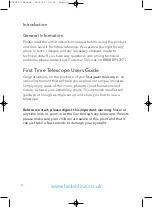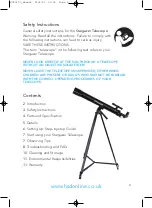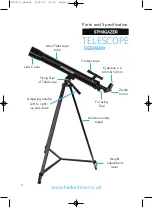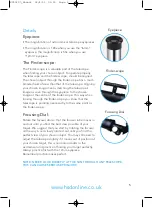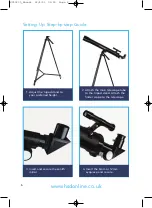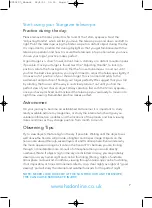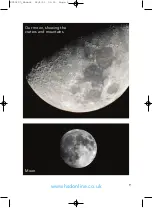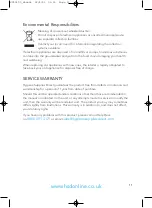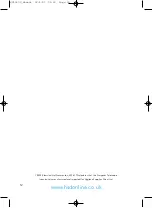
www.hsdonline.co.uk
8
The Moon:
The moon is the easiest target to find at night. When the moon is in full position, it
bathes the night with a silvery light that washes the sky of all but the brightest
objects. The best time to view the moon is not when it is full, but rather when it is
less than half full. The dividing line between dark and light on the moon, called the
terminator, shows the best detail.
Troubleshooting and frequently asked questions
Q: I can’t get to focus my telescope, only get a bright circle.
A: Make sure you have inserted the diagonal Zenith mirror and an eyepiece (start
by the lowest power eyepiece – 12mm).
Q: I use the finder-scope to point to objects but I always miss the
target.
A: You probably need to realign the finder-scope on the target if you accidentally
nudge the telescope. After and learning how to tighten the telescope into
position of the target you will find you improve on this.
Q: The stars only appear as points in the telescope, is this normal?
A: This is normal. Stars will always appear only as points, even in the largest
telescopes in the world. It is more interesting for beginners to observe two-
dimensional objects, such the moon or planets. Once you find these, you will
be able to start learning about the astronomical calendar.
Q: I can’t see anything when I look through my telescope.
Did I do something wrong?
A: Check you have removed all the lens dust caps. All telescopes are only suitable
for astronomical observing and when used outside at night when the sky is
clear is when you achieve the best results. Observing from inside a house
through a window or during the day is not usually best practice unless
practising and learning how to use the telescope.
NOTE: NEVER LOOK DIRECTLY AT THE SUN THROUGH ANY TELESCOPE;
THIS CAN CAUSE SERIOUS EYE INJURY.
Please Note: If you wear corrective lenses (specifically glasses) you may want to
remove them when observing with an eyepiece attached to the telescope. If you
have astigmatism then corrective lenses should be worn at all times.
SG50600_Manual 26/4/21 09:59 Page 8


